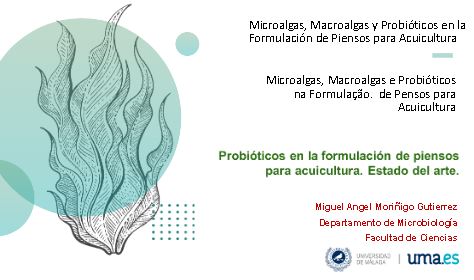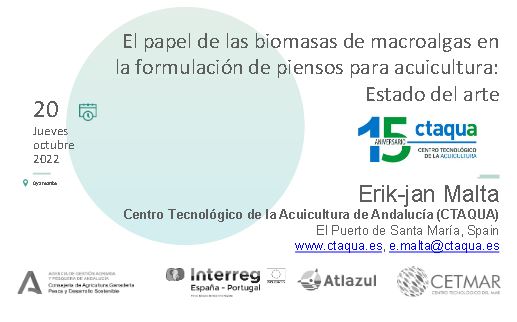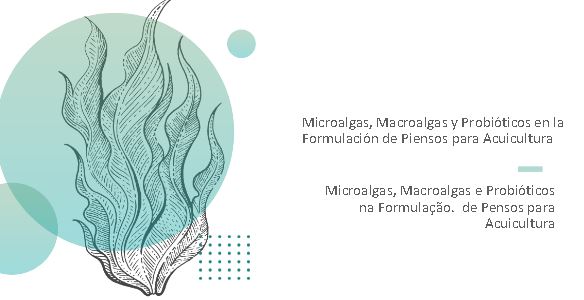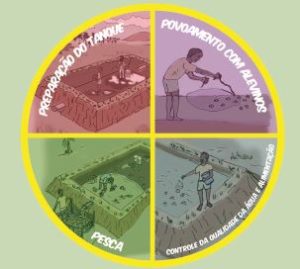Introducci´ón
Enlace a la ponencia: MIGUEL A. MORIÑIGO – Probióticos en la formulación de piensos para acuicultura. Estado del arte. Video de la ponencia enlace a youtube: Video

Enlace a la ponencia: MIGUEL A. MORIÑIGO – Probióticos en la formulación de piensos para acuicultura. Estado del arte. Video de la ponencia enlace a youtube: Video

Introducci´ón
ERIK MALTA: Papel de las biomasas de macroalgas en la formulación de piensos para acuicultura. Estado del arte. Video de la ponencia enlace a youtube: Video

Enlace a la ponencia: Papel de las biomasas de microalgas en la formulación de piensos para acuicultura. Estado del arte. Video de la ponencia enlace a youtube: Video

Introducción
Enlace a la presentación: Artemias y rotíferos como alimentación en las primeras etapas. Mejora de su perfil nutricional en base a microalgas

Autora: Patricia Diogo. Gestora de Innovación y desarrollo de producto.
El Proyecto Piloto de Transferencia (PTT) “Proyecto de fortalecimiento a la
producción sostenible de la piangua en el municipio de Tumaco”, integrado en el Programa DIRENA, se enmarca dentro del Plan de Desarrollo de Tumaco-Tumaco Nuestra Pasión 2016-2019.
En este marco, y desde la perspectiva de la transferencia de experiencias y conocimiento desde España, se planteó el diseño de planes de manejo del recurso, la profesionalización y organización del sector piangüero, así como la mejora de la calidad de los procesos de cultivo, trazabilidad y comercialización de este recurso.
La presente guía de diversificación acuícola hacia el cultivo de macroalgas se realiza en el marco del proyecto ACUIPESCA PERÚ – “Incrementar la productividad del sector pesca y acuicultura en la bahía de Sechura a través del fortalecimiento institucional y organizacional, la adopción de tecnologías y la sostenibilidad ambiental”, en colaboración con el Ministerio de la Producción de Perú (PRODUCE) y con financiación de la Xunta de Galicia (Gobierno Regional Gallego). El proyecto es ejecutado por un consorcio coordinado por el Centro Tecnológico del Mar – Fundación CETMAR en colaboración con el Ministerio de la Producción con ANFACO – CECOPESCA y la Fundación Ayuda en Acción como socios estratégicos.
En el presente trabajo se plantea la diversificación acuícola hacia el cultivo de macroalgas como estrategia de mejora y garantía de sostenibilidad de la producción acuícola en la bahía de Sechura. Con la producción de algas se busca generar una diversidad productiva que garantice un retorno económico, combinándola con los cultivos tradicionales de concha de abanico (Argopecten purpuratus), avanzando hacia una visión multitrófica de la acuicultura. Las algas, además de ser consumidas de forma directa a lo largo de todo el planeta y ser materia prima para diferentes ficocoloides, actúan como áreas de reclutamiento, liberan oxígeno al medio y retiran nutrientes, mejorando la calidad de las aguas donde habitan.
El propósito de esta guía, es facilitar una herramienta sencilla y visual que ayude a los productores acuícolas artesanales a diversificar su actividad hacia el cultivo de macroalgas, sabiendo qué factores se deben tener en cuenta para elegir las especies idóneas, así como las técnicas más apropiadas de
Como señala la Organización Mundial de Sanidad Animal (OIE), en las últimas décadas la producción mundial de moluscos se ha visto seriamente afectada por numerosas enfermedades. Debido al severo impacto que producen, algunas de estas enfermedades se han convertido en una seria restricción primaria para el desarrollo y sostenibilidad de los
cultivos de moluscos, afectando al desarrollo socioeconómico de muchos países. Actualmente, se considera que la principal causa asociada a los brotes epidémicos es la transferencia de agentes infecciosos a través del transporte de moluscos vivos.
La dinámica de libre comercio y el legítimo deseo de los países de buscar nuevas alternativas para la producción de alimento y de desarrollo económico, hacen que se pasen por alto factores sanitarios esenciales que, de no considerarse en su justo contexto, pueden provocar el fracaso de los cultivos de moluscos.
En esta Guía pretendemos trasladar el conocimiento que se ha generado en el ámbito científico a lo largo de los últimos años.
Esta información puede ser de utilidad para la industria, con el fin de intentar prevenir la introducción y diseminación de la enfermedad causada por el virus herpes de los ostreidos OsHV-1 y su variante OsHV-1 μVar, mitigando de esta forma las pérdidas económicas asociadas a la misma y promoviendo por ende la competitividad del sector.
Este caderno de piscicultor foi realizado no enquadramento do projecto “Reforço da Acuicultura Rural a Pequena Escala e a Investigação Pesqueira em Cabo Delgado, Moçambique”, financiado pela Xunta de Galicia através de Cooperação Galega, e executado pelo Instituto Nacional de Desenvolvimento dá Aquacultura (INAQUA) e o Centro Tecnológico del Mar-Fundação CETMAR.

Este material apresenta-se como uma ferramenta de trabalho dirigida aos aquacultores rurais para facilitar a tomada de dados e assim melhorar o controlo da produção e realizar uma gestão responsável e posterior comercialização. Com a informação obtida o INAQUA poderá orientar a tomada de decisões para o desenvolvimento e melhoria da qualidade de vida dos acuicultores rurais.
Aquaculture is a young sector which has been showing in recent years
an unstoppable, exponential and irreversible growth. This trend can only
continue as long as the supply of certain raw materials like fish oils and
meals, which are essential for the manufacturing of feed, may grow in line
with it. This is the only bottleneck for the future of aquaculture: fish oil
production is at a standstill. The massive and traditional sources of fish oil
have been based and in fact, they are still supported by the exploitation
of great biomass of marine species. These and many other fisheries are
nowadays technically declining and socially under question.

Fish meals and oils go through the same processing; both depend highly on
wild fisheries as Peruvian anchovy (Engraulis ringens) which are under a high fishing pressure. This situation together with other new phenomenon like climatic change could explain its stagnation or even recession. This would be completely negative for the aquaculture sector whose needs of fish oil for year 2030 are estimated at 40 million tonnes.
To consolidate the desired and rapid growth, aquaculture should base its
expansion in a greater diversification of the sources of raw material regularly used. This is not a new statement and it has been assumed a long time ago by the whole industry in this activity despite of some remarkable problems.
Thus there is a clear research line, not yet fruitful, focused on identifying
renewable (vegetal) sources of n-3 long chain polyunsaturated fatty acids
(n-3 LC-PUFA) as a partial alternative to fish oils. Likewise there are many
efforts addressed to obtain protein concentrates of vegetal origin with the
same purpose.
Apart from identifying and introducing alternative ingredients the
evolution of feed formulation to obtain the best nutritional profiles requires
unavoidably new additives. Additional problems such as high densities and
the subsequent risk of disease transmission; limited and even forbidden
use of antibiotics; together with feed with a high vegetal content, lead to
a reduction in survival and growth as well as a lower efficiency in feed use.
All these disturbances make aquaculture activities not very profitable. In
order to promote growth and an adequate health condition there are several useful tools to be used. Some of them are: the inclusion of natural growth promoters in feed, the use of lactic bacteria to enrich cultures of Artemia and rotifers in hatcheries, as well as the combination of mineral vitamin markers with immune stimulant activity. Many of these substances have shown to affect certain species causing benefits derived from their antimicrobial effects, effects on the development of the intestinal epithelium, antiinflammatory or digestibility improver.
5 Economically speaking the great price variation in feed ingredients and the low market prices for products from aquaculture, challenge the benefit of many aquaculture activities around the world. As production costs increase, nutritionists look for new ways to reduce them, maximizing digestive and metabolic activities as a base to turn nutrients in growth. Additives to increase digestibility have the ability to improve the use of nutrients from economical ingredients and encourage their transformation in food/meat.
They also cause a reduction of fat accumulation in muscle and guts.
The Centro Tecnológico del Mar-Fundación CETMAR organized on the 29th
September 2011 a seminar titled “Use of New Additives in Fish Feeds”
about the relevant role of technological additives and vegetal ingredients
in feed formulation (seminar organized within ZIMOFEED project
PGIDIT08MMA003CT, financed by Tecnoloxía Sectorial MMA Program,
Consellería de Economía e Industria). The seminar aroused a great interest
and had a remarkable reception. All along the event the audience showed a
great interest about the subject. Thus, the idea of publishing this book was
born to collect all the information released during that seminar in a way that all the different issues involved nowadays in this subject were represented.
Obviously, the intention is to serve as an orientation to those who want to
study in depth these applied aspects of aquaculture research and nutrition.
This book would not have come true if we had not counted on the selfless
help of a number of professionals and companies. We could not have reached our goal without their generous contribution. Especially we must mention the following companies DIBAQ SA, NUTRIAD and NOREL SA whose firm commitment with aquaculture has make this book possible. We are in debt with all scientists and company representatives who have given shape to the book as well as to the seminar. To all of them we thank from these pages for their altruistic effort and compromise and confirm our gratitude and recognition.